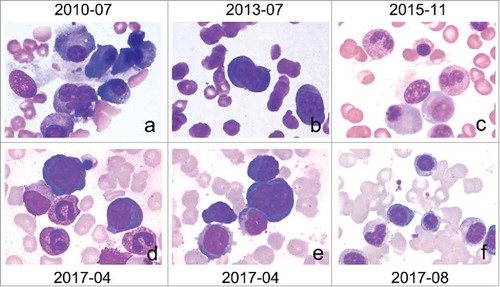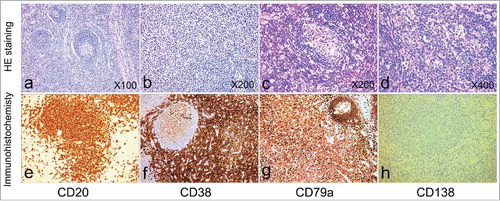Figures & data
Figure 1. Bone marrow cytomorphologic examination: a. Bone marrow primarily showed active hyperplasia, granulocyte cytoplasm particles increased and common bloodthirsty cells in the July 2010. b. Reexamination of bone marrow due to negative outcome of chemotherapy for MCD showed the same with the last which not suggested hematological malignancies in July 2013. c. In November 2015 the bone marrow showed Active bone marrow hyperplasia, mature plasma cells increased, accounting for 7.0%. d and e. In April 2017, the patient came to hospital due to fever with pancytopenia and bone marrow showed plasma cells obviously increased with 29.5%, and proplasmacyte seen, which can be diagnosed MM accompanied with other examination. f. After therapy, Reexamination of bone marrow was positive with the plasma cells decrease to 3.5% in August 2017.

Figure 2. Histological findings: The left cervical lymph node biopsy in patient. a-d: The hematoxylin and eosin stained section showed lymphoid hyperplasia with numerous plasma cells in interfollicular region and no hyaline vascular in July 2010. Immunohistochemistry features: e. cluster of differentiation 38 antibody confirming the presence of numerous plasma cells f. cluster of differentiation 20 (+) g. cluster of differentiation 79a (+) h. cluster of differentiation 138 (-).

Figure 3. The variations of laboratory parameters. The picture of A and B represent respectively Hemoglobin and Platelet counts of the patient and these parameters was tested before transfusions with blood cells or platelet. (C) C-reactive protein (CRP): the level of CRP has not been decline when used ECHOP regimens but there had been obvious respond to thalidomide. And when the patient was diagnosed MM, the CRP had been increased dramatically. a: the patient was diagnosed plasma-cell MCD. a-b: the patient received chemotherapy of cyclophosphamide, vincristine, doxorubicin and prednisone with VP16 (ECHOP) regimen. c: the patient started oral thalidomide combined with prednisone because the MCD was advanced and the effect of chemotherapy was not as expected. d: the MCD turned to MM and the laboratory parameters was both worsen, but then have been better gradually after therapy.

